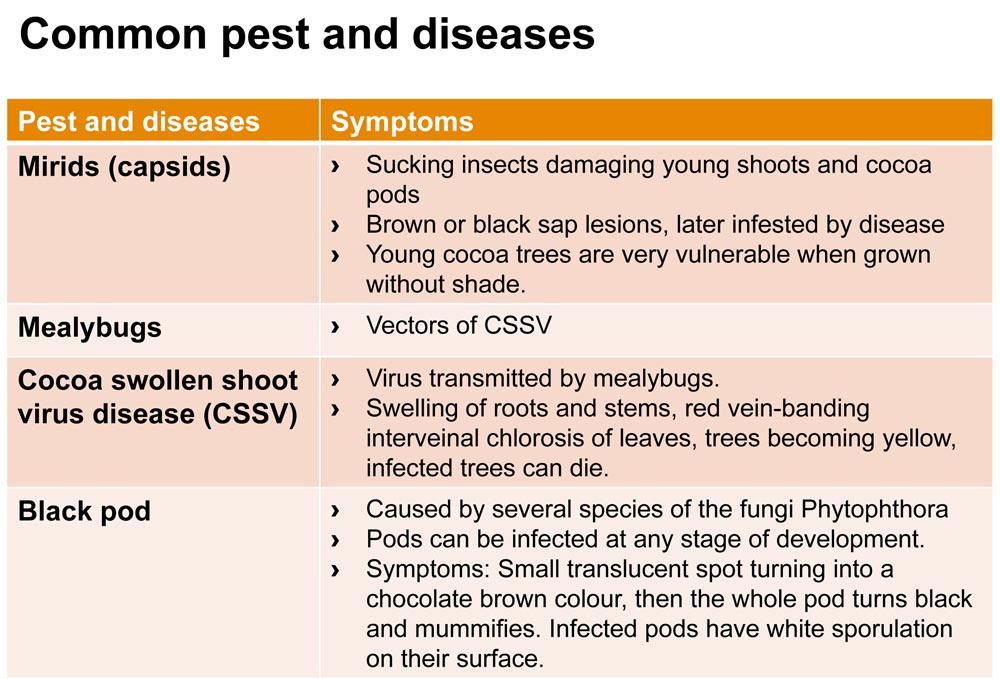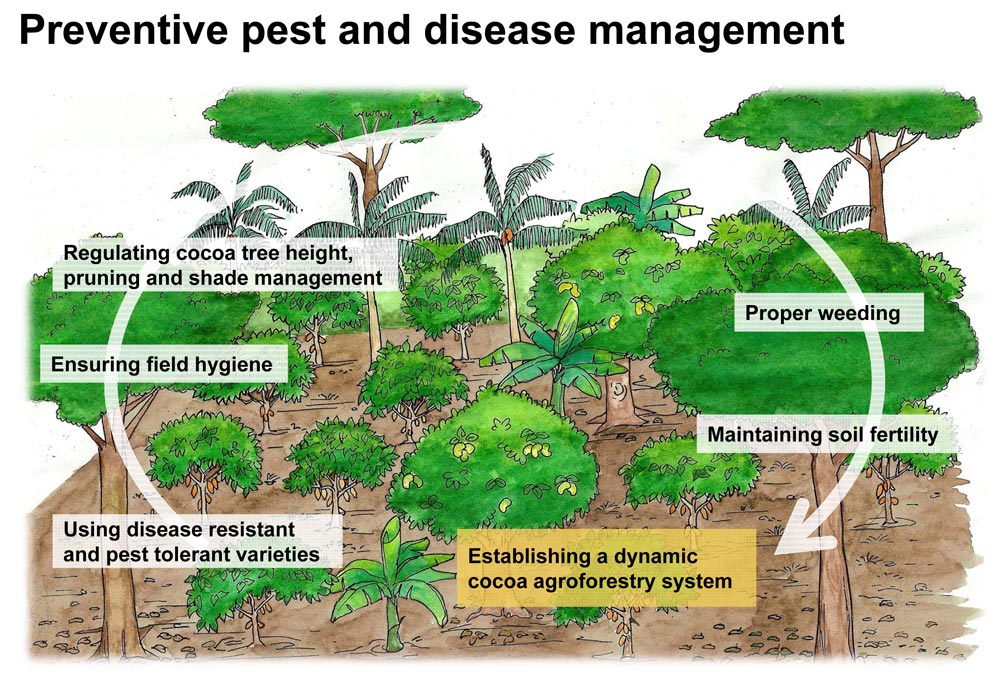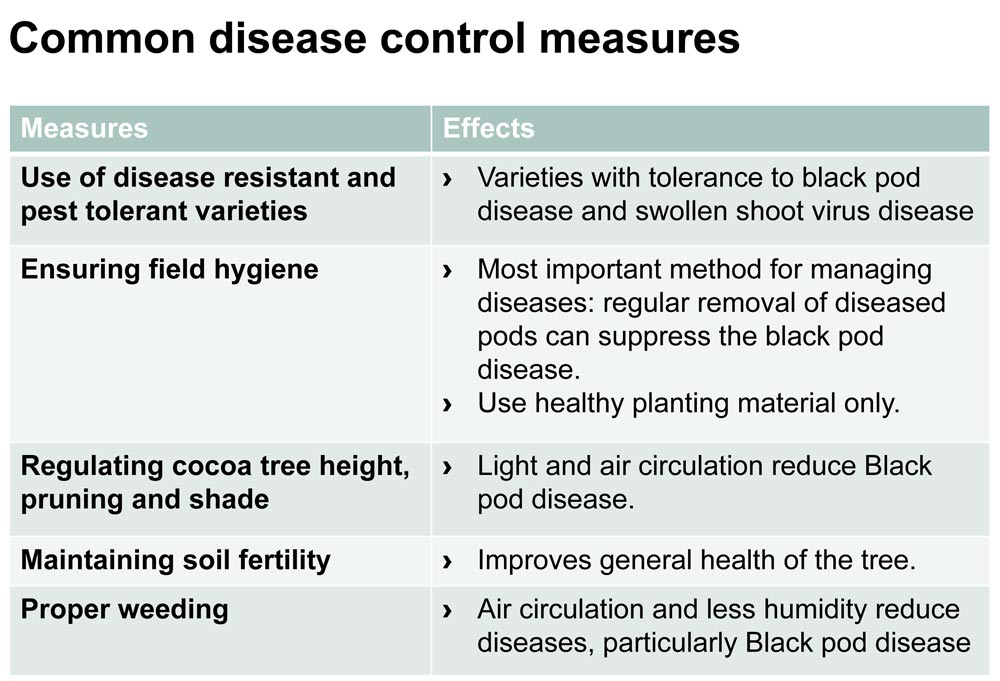Management of pests and diseases
Cocoa can be affected by many pests and diseases, which thrive well in the warm and humid climates where cocoa is commonly grown. However, with proper understanding and implementation of a natural agroecosystem, pests and diseases can be effectively managed.
Several experiences and research have shown that it is possible to reduce pests and diseases in cocoa significantly, only by modifying a production system to a more dynamic agroforestry system. A series of relationships have been observed between the supply of light, air, water and nutrients to the cocoa system on one hand and the appearance of diseases and pests on the other hand.
Most pest and disease infestations have been found to occur under the following conditions:
- Ignoring the succession sequences of forest systems. Having originated in the primary forest, cocoa can well endure old primary forest tree species as shade trees, but not old secondary trees.
- Cultivation of cocoa monocultures with a few shade trees and species only.
- High density of vegetation due to densely-spaced plantation and failure to thin and prune the trees. This creates a conducive, humid environment for the cocoa pests and diseases.
Generally proper management of pests and diseases can be achieved by:
- Using disease resistant and pest tolerant varieties - Cocoa varieties with tolerance to black pod disease and swollen shoot virus disease exists, for example, in West Africa. Local cocoa research institutes may inform about their availability.
- Ensuring field hygiene - This is probably the single most important method for managing key cocoa diseases. All diseased or infected plants, pods and other plant parts should be removed from the plantation and destroyed. It has been shown in West Africa that regular removal of diseased pods can suppress the black pod disease. Another hygiene measure concerns planting materials for establishing new cocoa fields. To ensure healthy planting material shoots should be taken from non-infested trees and plantations only.
- Regulating cocoa tree height, pruning and shade management - Removal of some branches of cocoa and shade trees by pruning and proper maintenance of the height of the cocoa trees will allow light to penetrate to the centre of the tree, and will increase air circulation. Both make the conditions unfavourable for the black pod disease. Removing shade trees with a shorter life cycle than cocoa at the end of their life cycle is an important measure to be undertaken in this concern.
- Maintaining soil fertility - Efforts for improving soil fertility are critical, particularly where cocoa is grown on poor soils with low nutrient levels, to ensure general health of the tree.
- Proper weeding - Weeding increases air circulation and reduces the humidity in the plantation and thereby reduces the incidence of diseases, particularly the black pod disease.
Soil protection and weed management
In a sustainable cocoa plantation the soil is covered mainly by spontaneous vegetation and cocoa leaves, which protect the soil against erosion. However, leguminous cover crops can also be grown in between the cocoa trees. Weed control is critical in the early stages of establishment in order to avoid competition with young cocoa plants for soil nutrients and water. Weeding also increases air circulation and reduces relative humidity and thereby reduces the incidence of black pod disease. Normally when the canopy is formed, weed growth is completely suppressed. Traditionally weeding is done manually by slashing around trees.
Management of cocoa pests

The most common pests in Africa are mirids or capsids (Distantiella theobromae and Sahlbergella singularis) and mealybugs (Planococcus, Stictococcus). Mealybugs are mainly a problem as vectors of cocoa swollen shoot virus (CSSV) . Mirids (capsids) are sucking insects. They damage young shoots and cocoa pods thereby reducing the yield of cocoa. Feeding by mirids is characterized by brown or black sap lesions that are later infested by disease. Young cocoa trees are very vulnerable to attacks of mirids when they are grown without shade.
Management of cocoa diseases
In Africa, the main cocoa diseases are the black pod and cocoa swollen shoot virus (CSSV).
Cocoa swollen shoot virus disease (CSSV)
The disease is caused by the swollen shoot virus and is a major problem in all cocoa growing regions. CSSV is transmitted by mealybugs such as Planococcoides. Symptoms include swelling of roots and stems, red vein-banding interveinal chlorosis of leaves, trees becoming yellow, and if there is a severe viral attack, infected trees die.
Black pod


This disease causes the most important yield losses in cocoa worldwide. It is caused by several species of the fungi Phytophthora. Two species—P. megakarya and P. palmivora – cause this most important yield-limiting disease in the African cocoa industry. Although Phytophthora species attack all parts of the cocoa tree, the major economic loss comes from infection of the pod. Pods can be infected at any stage of development.
Symptoms include the appearance of a small translucent spot. The spot turns into a chocolate brown colour, then darkens and expands until the whole pod turns black and mummifies. Infected pods also have white sporulation on their surface. This sporulation becomes denser as the disease progresses.
Email: Editor@agricinafrica.com

Comments
Post a Comment